News
2015 LDI Fall Kickoff Report
Meet the 15 New LDI Senior Fellows
Each year, the Leonard Davis Institute of Health Economics (LDI) hosts a special “Fall Kickoff” to introduce its newly-appointed Senior Fellows. Held on the Moelis Terrace of Van Pelt-Dietrich Library, this year’s event featured twenty Penn health services researchers whose work and collaborations spanned a broad range of interests including behavioral economics, health informatics, childhood and adult obesity, and adolescent risk and injury prevention. Below (in the order of their podium appearance) are photos, audio clips and brief synopses of their presentations.
~ ~ ~
1. Roy Rosin, MBA
Chief Innovation Officer, Perelman School of Medicine
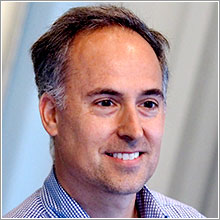
NEW APPROACH TO HEALTH CARE INNOVATION
The former First Vice President of Innovation at the software giant Intuit, Roy Rosin is the Chief Innovation Officer at the three-year-old Penn Medicine Center for Health Care Innovation and part of a research team focused on reinventing health care delivery in ways that lower cost and increase quality. He’s made headlines with his approach of adapting software marketing techniques to the task of quickly assessing the viability of potential clinical break-through concepts. “In the technology industry,” he said, “we did a lot of work converting ideas into actions and outcomes which made a big difference and in a sort of post-career, I wondered if I could do the same thing in a place with more social meaning — and Health Care seemed to be a good place to at least try.” | See bio page |
2. Anne Barnhill, PhD
Assistant Professor, Medical Ethics and Health Policy, Perelman School of Medicine
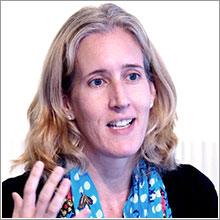
THE ETHICS OF NON-RATIONAL INFLUENCES
Messaging that uses emotions to change behavior (better known as advertising) and nudges that passively encourage or physically require different behaviors are the focus of philosopher Anne Barnhill’s current research. Both are called non-rational influences and both, she noted, have drawn the ire of philosophers, ethicists and pundits who have characterized such techniques as unethical manipulations. “The questions I’m interested in asking,” she said, “include ‘what exactly is a manipulation?’, ‘are methods of non-rational influence manipulative?’, and ‘what do people mean when they say (these methods) are manipulative?’.” She went on to ask the audience to help her by providing their favorite examples of compelling advertising messaging and nudges. | See bio page |
3. Nabila Dahodwala, MD, MS
Assistant Professor, Neurology, Perelman School of Medicine
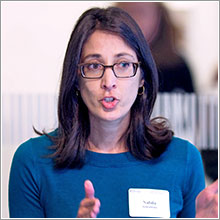
IMPAIRED GOAL-DIRECTED BEHAVIOR
Apathy — the lack of goal-directed behavior — is a potential research subject of interest to neurologist Nabila Dahodwala. It’s also a serious issue in the ongoing care of patients with Parkinson’s, Alzheimer’s and a variety of other neuro-degenerative diseases. Dahodwala explained that, depending on the disease and section of the brain affected, a patient can have “impaired initiation.” This means they don’t want to start an activity or make a plan. They are not motivated by rewards or punishments. They tend to sit on a couch and watch TV all day and don’t adhere to treatment plans or exercise and subsequently have much poorer outcomes. “Unfortunately, the current treatments for impaired goal-directed behavior are lacking,” said Dahodwala. “I would love to develop an intervention and test it.” | See bio page |
4. David Fajgenbaum, MD, MBA, MSc
Research Assistant Professor, Medicine, Perelman School of Medicine

SIMULTANEOUSLY INVESTIGATOR AND PATIENT
David Fajgenbaum’s research is unusual in that he is both investigator and patient. Afflicted with Castleman disease, a rare, incurable and life-threatening disorder of the lymphatic system, he is the co-founder and executive director of the Castleman Disease Collaborative Network. “Our approach,” he explained, “was to first identify and connect all the physicians and researchers worldwide who are interested in Castleman disease research or are currently conducting research. Then we leveraged that community to prioritize what research should be done into what we call our international research agenda. In our third stage, we go out to patients and loved ones with specific needs for specific projects to raise funding and acquire tissue samples. And then we recruit the top researchers around the world for that particular study.” | See bio page |
5. David Goldberg, MD, MSCE
Assistant Professor of Medicine, Perelman School of Medicine
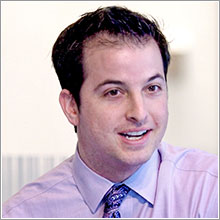
GEOGRAPHIC DISPARITY OF ORGAN DONORS
The overarching framework behind David Goldberg’s research can be found in the Department of Health and Human Services’ Organ Procurement and Transplantation Network statistics showing that 122,478 patients are currently awaiting organ transplants but only 7,322 donors are available. A widely quoted authority in the field, Goldberg focuses on widespread geographic disparities in the number of donors and the availability of organs. “This has gotten the attention of lobbying groups and of politicians who, actually, for the first time have united, Democrats and Republicans, based on geography and not party lines,” he said. “Keep in mind that the sort of net revenue on a liver transplant is in the realm of one to two hundred thousand dollars, so there is a lot of money involved in this.” | See bio page |
6. Amy Jordan, PhD
Director, Graduate Student Professional Development, Annenberg School for Communication
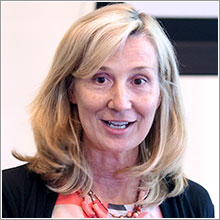
THE MEDIA’S IMPACT ON CHILDHOOD HEALTH
A scholar in the field of communications, Amy Jordan is a member of the University of Pennsylvania’s one-year-old Prevention Research Center funded by the Centers for Disease Control. The overall emphasis of her work is on media and health. “About ten years ago,” she explained, “I began thinking about health as an outcome of youth’s media use and specifically focused on childhood obesity and its connection to heavy media use. I began working with the Philadelphia Department of Public Health in a campaign aimed at reducing children’s consumption of sugar-sweetened beverages and we struggled with the ethical issues raised by that kind of messaging in public service announcements.” Currently Jordan is part of a team testing communications strategies aimed at decreasing young women’s use of indoor tanning. | See bio page |
7. Craig Konnoth, JD, MPhil
Lecturer, Law, Penn Law School
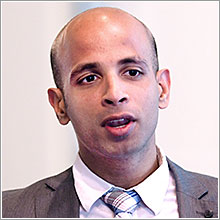
RETHINKING HEALTH INFORMATION COLLECTION
“Traditional forms of health information collection are not routine, not universal and not focused on the general public good,” said bioethicist and lawyer Craig Konnoth. “I argue that the government should take a bigger role in this to reduce anti-competitive and proprietary problems that come with private collection of health information.” Konnoth’s research looks at the mass collection of health information and the secondary research that’s performed on it. One of his ideas is that this process should adopt a model similar revenue taxation. “Data would be collected just as revenue is collected. You get health benefits and you pay back in the form of your health information,” he said. “The normative justification is you’re collecting the resource as a reciprocation for the benefits you obtained from having the resource in the first place.” | See bio page |
8. John MacDonald, PhD
Professor, Criminology and Sociology, School of Arts and Sciences
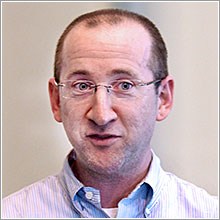
MANIPULATING THE BUILT ENVIRONMENT
“Poor health and high crime are geographically concentrated in the same places,” said criminologist John MacDonald who researches the connections between built environments and community behavior. He is also the Faculty Director at Penn’s Fels Institute of Government. In collaboration with LDI Senior Fellow Charles Branas, he is studying the effect of vacant housing remediation on crime levels in inner city neighborhoods. “We’re looking at remediation through Philadelphia’s ordinance that requires working windows and doors to be installed on vacant houses,” he said. “It’s hard to know the exact causal mechanism because most of the research is observational. We don’t have lots of clinical trials about manipulating the adult environment.” But his team has found positive effects comparing remediated houses to unremediated control houses. | See bio page |
9. Catherine McDonald, PhD, RN
Assistant Professor, Penn School of Nursing
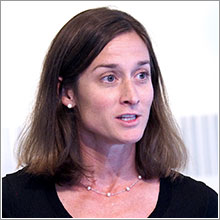
MEASURING TEENAGE DRIVING ERRORS
Catherine McDonald, an Assistant Professor at both Penn’s School of Nursing and the Perelman School of Medicine, is particularly interested in adolescent risk and injury prevention in the areas of community violence exposure and driving behaviors. One of her current projects using a custom-built simulator to gather data about the skill levels and common errors of teenage drivers has been the subject of widespread publicity. She is collaborating with LDI Senior Fellow Flaura Winston on that work. “When we talk about teen driver inattention, we mean distractions of any kind,” she said, “texting and driving is a hot topic right now but we also think about others like peer passengers, external distractions and the young driver’s own skill.” She is currently enrolling newly-licensed teens in a larger trial. | See bio page |
10. Judith McKenzie, MD, MPH
Associate Professor, Emergency Medicine, Perelman School of Medicine
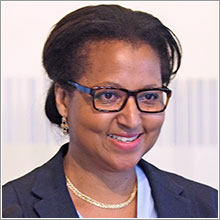
OCCUPATIONAL HEALTH ISSUES
When she was a young girl growing up in Jamaica, Judith McKenzie was impressed with the role the local Public Health Department played in the town’s daily life. Later she joined the Girl Scouts and became interested in medicine and ultimately went on to become a physician and Residency Program Director in Occupational and Environmental Medicine at Penn’s Perelman School of Medicine. “I went to (Yale University) medical school and practiced at Bellevue with the working poor before I ever heard about occupational medicine,” said McKenzie. “I looked into it, did a fellowship at Johns Hopkins in Occupational Medicine and here I am.” She notes that Penn has the country’s largest civilian occupational medicine residency program and is supported by National Institutes of Health and Health Resources and Services Administration grants. | See bio page |
11. Mitesh Patel, MD, MBA
Assistant Professor of both Medicine at the Perelman School of Medicine, and Health Care Management at The Wharton School
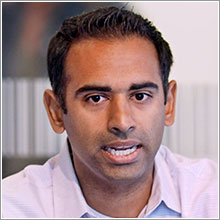
PERFECTING ‘WEARABLE DEVICE’ MEDICINE
Despite general press predictions about the potential for smartphones and other “wearable devices” to quickly revolutionize the clinician-patient relationship, researchers like Mitesh Patel have a different view. “A common mistake is to think you can just give someone a shiny new FitBit and make them a new person,” he said. “For one thing, patients who could most benefit from wearable technology tend to have no interest in such things, others who do buy FitBit-like devices often abandon them after the novelty wears off in a few months, and the technology itself is often inaccurate, diminishing users’ trust. Even when you can get the right people to use it and continue to use it and ensure the device is accurate, you have yet another challenge. Exactly how do you take the generated data and use it to sustainably change the patient’s behavior?” | See bio page |
12. Mohamed Rehman, MD
Professor, Anesthesiology and Critical Care, Perelman School of Medicine
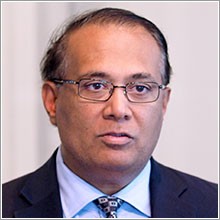
NEW INSIGHTS VIA OPTUM DATA SETS
Children’s Hospital of Philadelphia pediatric anesthesiologist and biomedical informaticist Mohamed Rehman noted that CHOP has “the largest pediatric anesthesia data warehouse in the world with 400,000 cases, including preoperative data, interoperative data and billing data.” And he sought collaborative help. “We are clinical scientists who are excellent at predictive analytic models but one thing we don’t have is somebody who can create financial predictive models. Using Optum data we obtained from LDI, we found the cost of tonsils and adenoid surgery can be anywhere from $3,000 to $25,000. We want to create a model for CHOP which is safe and the least expensive. We know how to do this from a medical standpoint but we want to look at collaborators from Wharton who can help us with financially modeling this data.” | See bio page |
13. Christina Roberto, PhD
Assistant Professor of Medical Ethics and Health Policy, Perelman School of Medicine
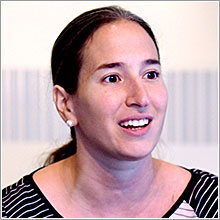
NUTRITION LABELING POLICY
Psychologist and Epidemiologist Christina Roberto is the creator of the PEACH Lab (The Psychology of Eating And Consumer Health Lab) at Penn’s Perelman School of Medicine. “What I’m trying to do is understand the social, environmental and psychological forces that promote unhealthy eating habits and come up with interventions or policies that promote healthier eating habits,” she explained. Her work primarily involves communications and market-type research. “I’ve been collaborating with lawyers,” she said. “And I recently began collaborating with anthropologists, clinical scientists and host of other people because food cuts across so many different areas. A lot of what I have focused on is the optimal design of nutrition information because that’s where a lot of the food policy action is at.” | See bio page |
14. Heather Schofield, PhD
Instructor, Medical Ethics and Health Policy, Perelman School of Medicine
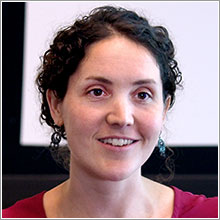
SLEEP DEPRIVATION AND LABOR PRODUCTIVITY
Health economist Heather Schofield is researching the connections between sleep deprivation, health and workplace effectiveness. “The research is about what are called ‘poverty traps’,” she said. “The basic idea is there could be environmental factors which influence people’s health and those health outcomes could, in turn, influence their productivity in the labor market. And then, that level of productivity feeds back into their poor health and poor environment.” She pointed out that, “All this is actually very theoretical literature to start with, so we’re trying to make it very empirical by saying, let’s take some actual environmental factors, think about health outcomes that they’ll cause, and then test whether or not breaking that link or changing that health factor actually influences people’s productivity and decision making.” | See bio page |
15. Minyuan Zhao, PhD, MPhil
Associate Professor, Management, The Wharton School
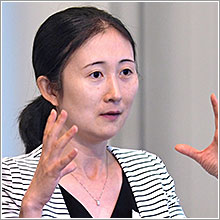
INTERNATIONAL PHARMACEUTICAL NETWORKS
Wharton School Associate Professor of Management Minyuan Zhao is researching international pharmaceutical companies that conduct R&D activities and management intellectual property rights on a global basis. She notes that from Silicone Valley in the U.S. to Shanghai in China these firms cluster tightly together “learning from each other, interacting with each other, and with employees going back and forth at the same time the companies are trying to prevent sensitive information from leaking.” One pattern she’s found: Companies located in a high risk areas like China — where intellectual property rights are not well regarded — tend to operate as national collaborations rather than as isolated companies. And as technology gets close to commercialization, it is picked up and transferred somewhere else within the organization for development.” | See bio page |







